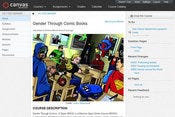Common Core Meets Aging Education TechnologyCommon Core Meets Aging Education Technology
Many K-12 schools struggle to implement new educational standards with old technology, outdated skills.


8 MOOCs Transforming Education
8 MOOCs Transforming Education(click image for larger view and for slideshow)
The Common Core State Standards program represents a huge shift in what teachers teach and students learn in the K-12 grades. The standards, which are focused on college and career readiness, rely heavily on effective use of technology for instruction, collaborative learning, assessment and data analysis.
However, as schools and districts across the United States begin to implement the standards -- 45 states plus the District of Columbia, four territories and the Department of Defense Education Activity have adopted them -- many are finding that there is a significant gap between the technology they need and the tech they actually have.
Several Common Core standards specifically require the use of technology. For example, a Grade 5 writing standard mandates that, "with some guidance and support from adults, [students will] use technology, including the Internet, to produce and publish writing as well as to interact and collaborate with others; demonstrate sufficient command of keyboarding skills to type a minimum of two pages in a single sitting."
[ Looking for ways to harness technology in the classroom? Read 10 Tech Tools To Engage Students. ]
Even if not explicitly stated, the level of collaboration, research and critical thinking inherent in the standards will require that educators and students have access to -- and knowledge about -- fairly advanced hardware, software and services. Further, the standardized assessments measuring students' understanding will be computer-based.
Unfortunately, what many schools are finding is that they don't have the technology they need, don't know what technology they need, or have the technology but not the knowledge and training to use it effectively.
When Robert Kravitz took on the role of superintendent of schools in Englewood Cliffs, N.J., he found the district had done everything right to develop the curriculum to meet the Common Core Standards, but it didn't have the technology infrastructure to support the implementation of the curriculum.
"Our curriculum matched but our tech didn't," Kravitz told information Education.
Kravitz said technology was lacking "everywhere, from devices to servers and switches to storage to the network to broadband and bandwidth."
There was some modern technology in the schools, Kravitz said. For example, all classrooms were equipped with interactive whiteboards. The problem, though, was that teachers had not been trained on the technology so the boards remained underused or unused altogether.
The first thing Kravitz did to overcome what he identified as a huge and pressing need was to bring in an in-house IT director and on-premises IT support staff, and phase out the outsourced IT services the district had been using. Kravitz and the IT director worked together to develop a plan, whose foundation was the replacement of bundled T1 lines with fiber. Next came new servers and switches, then a redesign of the wireless infrastructure.
Kravitz said the money came from redirecting funds and getting rid of programs that "schools tend to pay for over and over but that never get used." The district also relied on private donations.
The superintendent said that he and his team knew it would be critical to build the "highway" -- the network infrastructure -- before buying the "cars", or the end user devices.
Hilary Goldmann, senior director of government relations at the non-profit International Society for Technology in Education (ISTE), said many schools lack the highway necessary to support the kind of technology that the Common Core standards -- and modern, research-based teaching and learning models in general -- demand.
"Broadband is key to creating rich learning environments and assessments, and to support data-driven decision-making," said Goldmann in an interview with information Education. She added that the federal funding for broadband and other technologies needed for the kind of personalized education Common Core requires is far outstripping demand, a huge issue.
Testing, Testing
The "cars" running on Englewood Cliffs' info highway are new MacBook Air laptops.
The MacBook Air systems are leased, with an update every four years as part of the contract. The district purposely went with laptops instead of tablets to accommodate the redesigned curriculum, but also to prepare for the administration of the Partnership for Assessment of Readiness for College and Careers (PARCC) assessment. PARCC is one of two consortiums developing standardized assessments for the Common Core standards. The other is the Smarter Balanced Assessment Consortium. The assessments will be computer-based, replacing the "fill-in-the-bubble" paper-and-pencil standardized tests given in most states. This is a huge shift. In fact, schools might have the technology in place to support the Common Core standards in the classroom, but that doesn't mean they are set up for the coming standardized Common Core assessments.
"There are two different discussions that need to take place when it comes to Common Core. One is on instruction and the other is on testing and assessments," said Ernie Delgado, founder and co-CEO of Beyond Technology Education, an organization focused on training teachers and students to properly use technology. "They will be requiring laptops and tablets that, for example, need to have a certain screen size. And they have to be able to use a browser with certain security features. If you really want to be in compliance for the assessment aspect, you have to look at these kinds of minimums."
The state of New Jersey has adopted the PARCC assessment, which is scheduled to be administered starting in the 2014-15 school year. "We went with MacBook Air instead of a tablet knowing that by 2014-15 we have to be ready for the PARCC assessment," said Kravitz. "This will give us some time to get the kinks out of our system."
These kinks might include students' typing skills or, as the case might be, their lack thereof. In fact, said Kravitz, a teacher has been hired expressly to instruct students in kindergarten, Grade 1 and Grade 2 in typing skills.
Indeed, many of the experts interviewed for this story said schools assume that students have a high level of technology understanding. However, they said, although students might know how to play games and text, many don't know how to type with more than two fingers or to conduct basic operations in word processing and spreadsheet programs. The mistake schools are making is assuming too much tech knowledge and not teaching the basics.
The good news is that students typically are not afraid of technology and learn quickly. Teachers, on the other hand, represent a wider range of exposure to and comfort with technology.
Delgado said there is some debate on the ratio, but he has found that in any given school, 10% of teachers are very tech-savvy, 10% fear technology and 80% are somewhere in the middle. "The challenge is getting teachers comfortable [with the technology] and making sure that the curriculum is aligned," he said.
Kravitz said professional development focusing on technology will be a priority in his district, and he plans to hold parent tech nights to give parents guidance on what they can do at home to help their children develop their skills.
"There will be constant training," he said.
What Common Core tech challenges is your district facing? What are you doing to overcome them? Please let us know in the comments section below.
Follow Deb Donston-Miller on Twitter at @debdonston.
About the Author
You May Also Like






